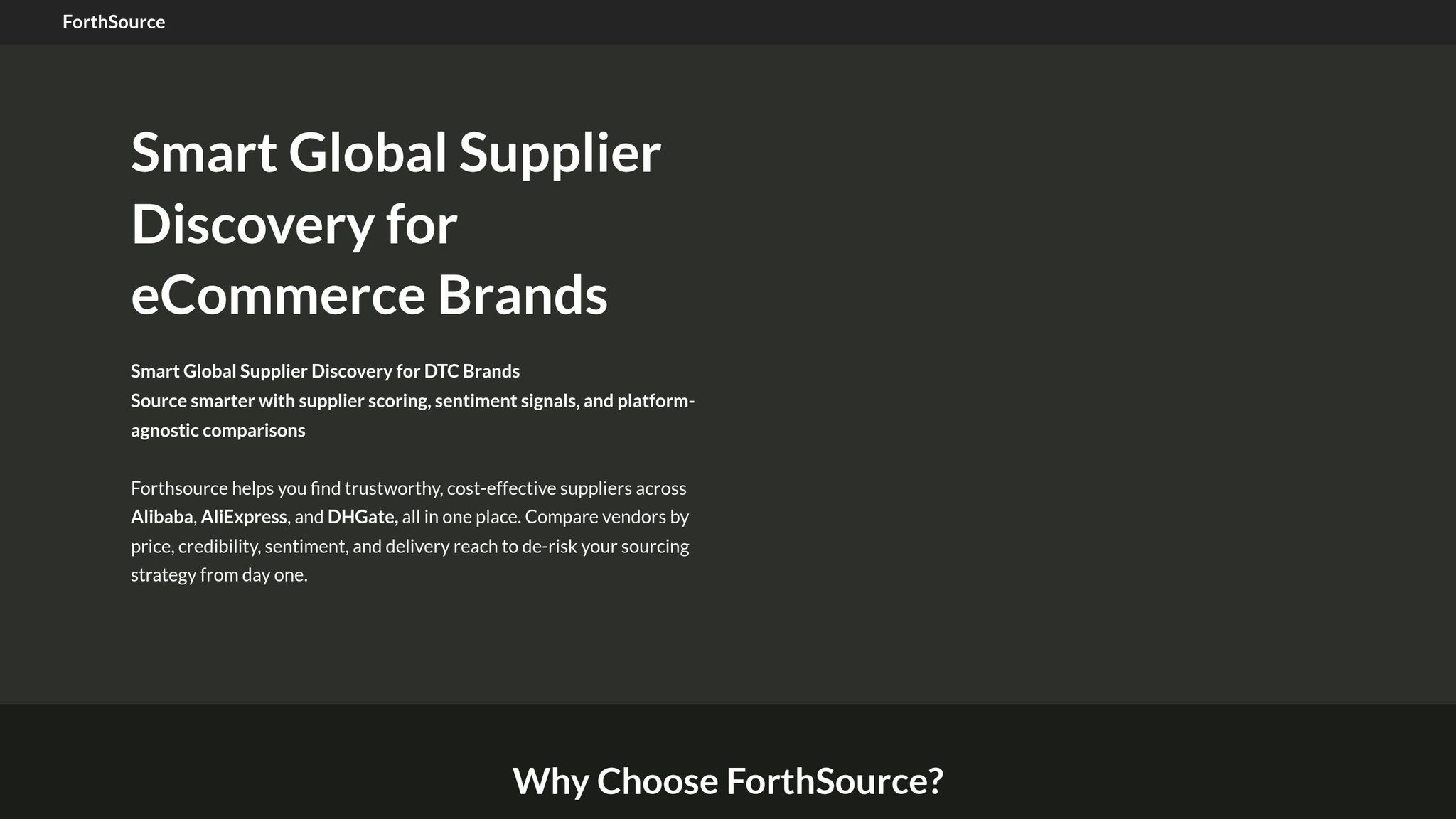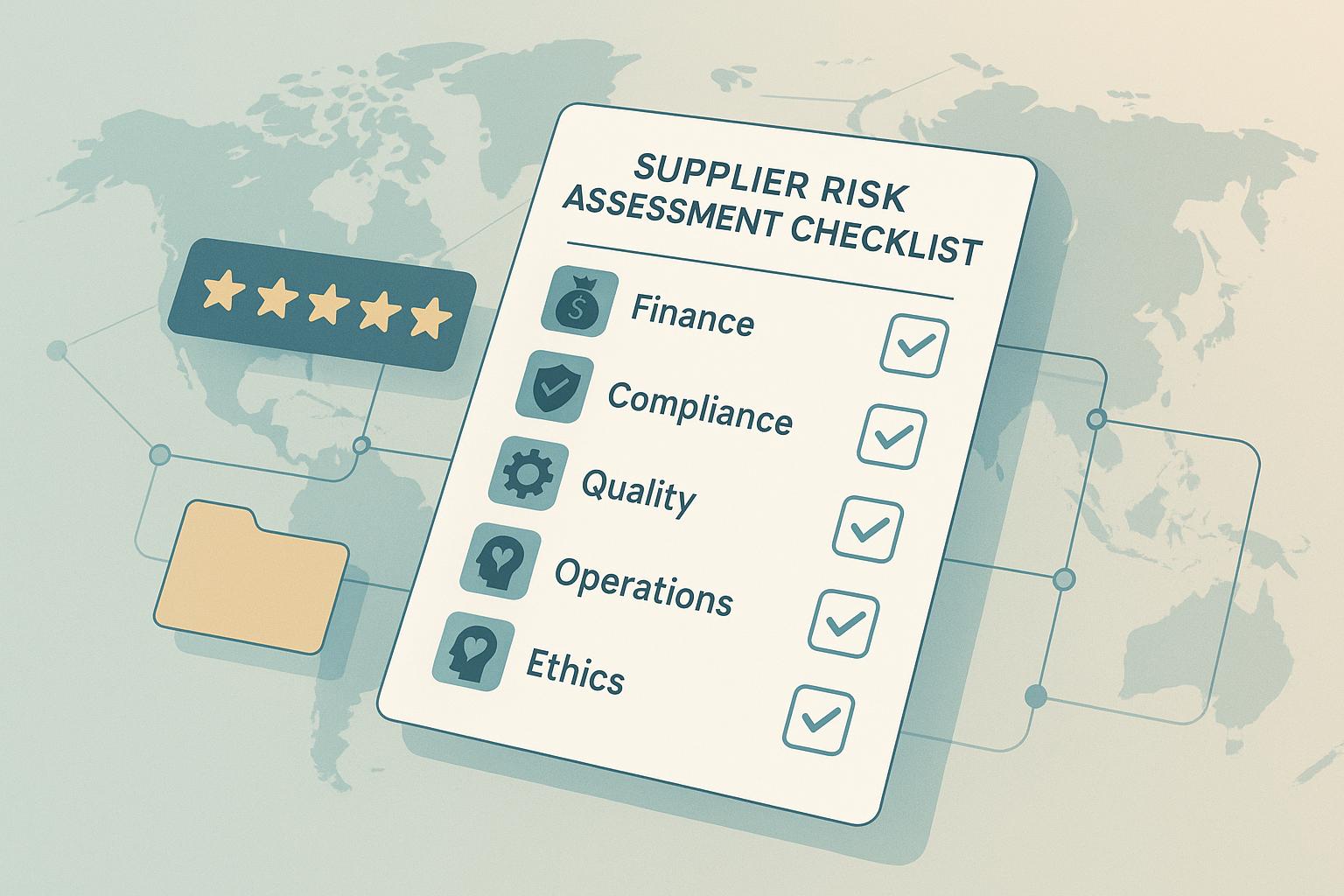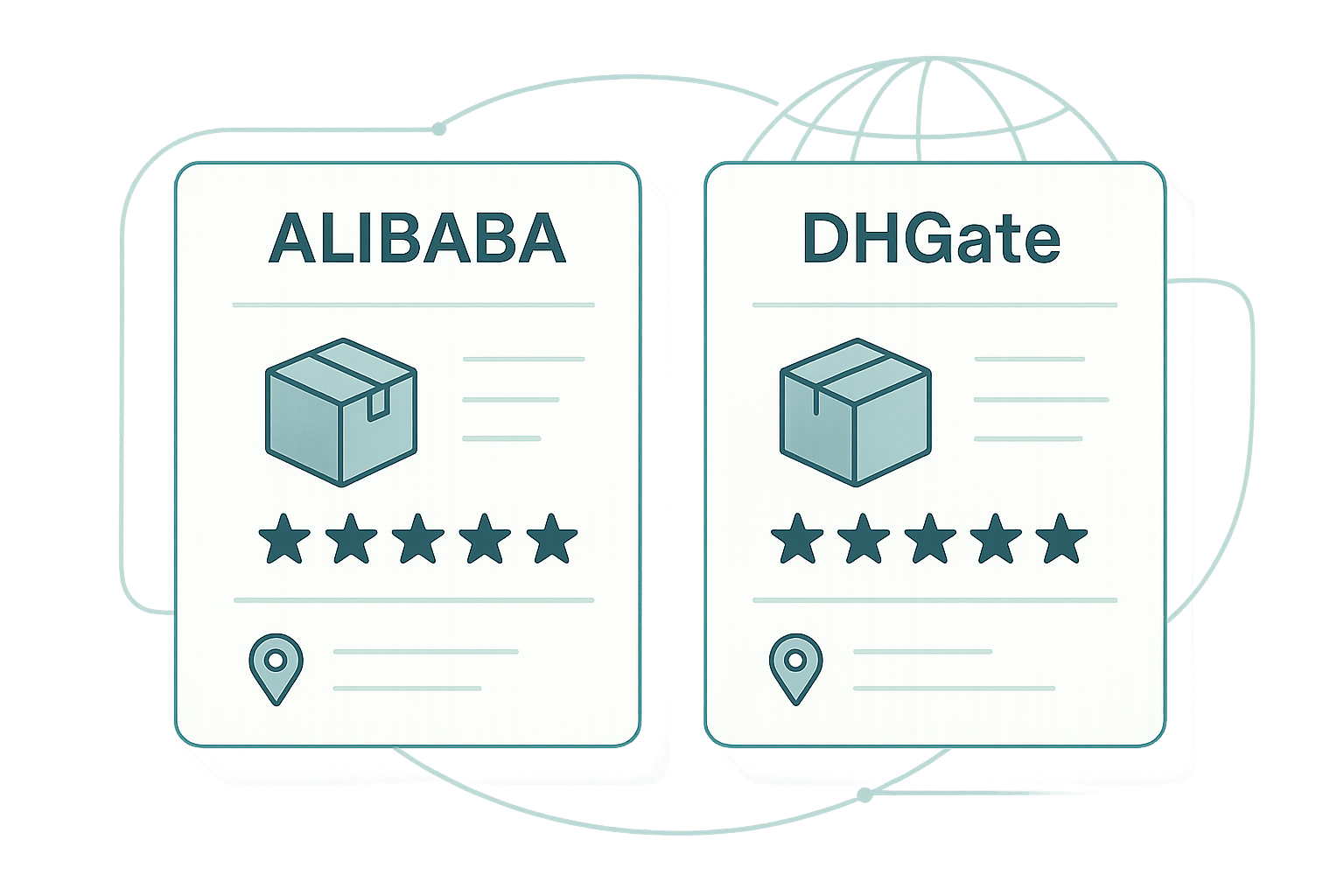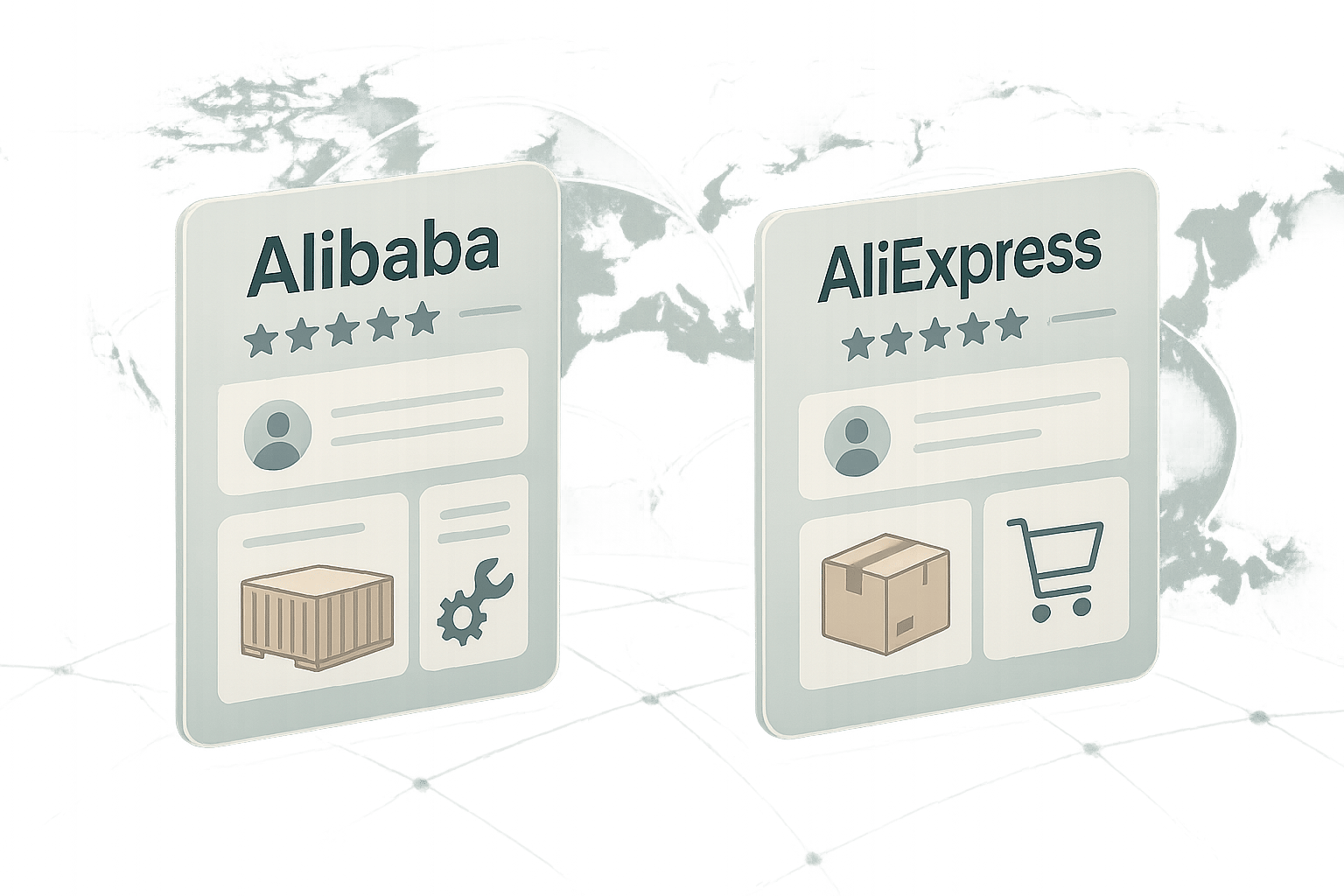AI is transforming how businesses find and evaluate suppliers. Instead of relying on slow, manual processes, companies are turning to AI agents that process real-time, structured data to deliver faster, more accurate results. Here's what you need to know:
- Traditional supplier discovery is outdated: Manual searches and static data often lead to missed opportunities and inefficiencies.
- AI agents use supplier metadata and trust signals: These include certifications, compliance records, and performance metrics, all analyzed in real time.
- Benefits for businesses: Procurement cycles are shortened by up to 40%, risks are flagged early, and costs are reduced by 7–12%.
- For suppliers: Structured, API-accessible data ensures visibility and direct connections to qualified buyers.
- ForthSource leads the way: This platform standardizes supplier data for AI systems, offering features like real-time updates, composite scoring, and seamless integration with US tools.
The shift toward AI-driven sourcing is reshaping procurement. Suppliers must provide accurate, API-ready data, while buyers need platforms like ForthSource to stay competitive. The future of procurement is here - faster, smarter, and more efficient.
What Are Supplier Metadata and Trust Signals
Defining Supplier Metadata and Trust Signals
Supplier metadata refers to detailed, structured data that outlines a supplier’s capabilities, products, and operational details. This can include product specifications, certifications, manufacturing capacity, compliance records, and other operational insights. Think of it as a supplier’s digital fingerprint, showcasing their ability to deliver.
Trust signals, on the other hand, are indicators that help assess a supplier’s credibility and reliability. These can range from domain trust scores and legal compliance checks to customer reviews and financial stability evaluations. Essentially, trust signals confirm whether a supplier is legitimate and dependable.
Why does this distinction matter? Traditional supplier information is often scattered across outdated PDFs, web pages, or catalogs, making it cumbersome to analyze. However, structured supplier metadata allows AI systems to process and compare thousands of suppliers at once. Key components like product catalogs, certifications, and capacity data become easily accessible and actionable.
"Trust in the data is based on our knowing that the data was sourced appropriately, is of good quality and has the consents necessary to be used. These Data Provenance Standards are an important step forward to ensure metadata about the sourcing, quality, and permissions are provided in a consistent manner." - Travis Carpenter, Mastercard Senior Vice President, Data Quality and Sources
This structured approach is especially valuable for AI-driven evaluations. For instance, when Samsung SDI’s factory in Göd, Hungary, lost its environmental permit due to non-compliance with noise, air, and water pollution regulations, the ripple effect impacted Samsung and other companies relying on that factory for components. If structured trust signals had been in place, compliance risks could have been flagged in real time. AI systems could have quickly adjusted supplier rankings and alerted procurement teams, potentially avoiding costly disruptions.
In short, structured supplier data is the foundation for AI systems to evaluate suppliers with speed and precision.
Why Real-Time and Structured Data Matter
Real-time updates are the game-changer that sets modern supplier discovery apart from outdated methods. When Apple faced supplier controversies, relying on static data proved to be a major setback. These incidents highlighted a critical truth: static supplier information is no longer enough.
AI systems need continuously updated, structured data to make informed decisions. Companies that prioritize rigorous supplier verification and compliance programs often experience fewer supply chain disruptions and save millions in compliance-related expenses. This level of efficiency is only possible when trust signals are updated in real time and presented in a structured format.
Take the automotive industry, for example, where external suppliers account for 70% of production costs. A single compliance issue or quality failure can ripple through the entire supply chain. With real-time, structured data, AI systems can monitor supplier performance continuously, flagging risks before they escalate into costly problems.
The structured nature of this data also enables AI to perform complex analyses in seconds - tasks that might take human teams weeks to complete. Instead of manually sifting through supplier websites, certifications, or references, AI can instantly cross-check financial stability scores, compliance records, and performance metrics across thousands of suppliers.
Master data management (MDM) systems are crucial in this process, offering a centralized hub for accurate, up-to-date supplier information. By ensuring data is both structured and current, businesses can make decisions based on real-world conditions.
For U.S. businesses, this translates to a competitive edge in speed and accuracy. While many companies still rely on manual supplier research, those leveraging structured metadata and real-time trust signals can onboard suppliers in days rather than months. The result? Stronger supplier relationships, fewer risks, and more efficient procurement processes. Real-time updates aren’t just helpful - they’re essential for AI-powered procurement strategies.
How AI Agents Transform Procurement
How AI Agents Evaluate Suppliers
AI agents are redefining procurement by moving beyond the capabilities of traditional software. While older systems focused on automating specific tasks, AI agents take it a step further by adapting their actions based on real-time data and context. Unlike conventional tools that rely on manual adjustments, AI agents operate autonomously, learning continuously, evolving workflows, and seamlessly managing exceptions. This shift allows organizations to prioritize strategic goals, flexibility, and broader business outcomes over mere efficiency.
When it comes to evaluating suppliers, AI agents excel by leveraging historical data, market trends, and supplier performance metrics. Through predictive analytics, they forecast conditions and guide smarter purchasing decisions. For instance, these agents can assess financial stability, compliance records, performance benchmarks, and market positioning across thousands of suppliers. Instead of sticking to rigid rules, AI agents use a mix of probabilistic and rules-based decision-making, ensuring they adapt to changing scenarios.
Statistics highlight this shift: 90% of chief procurement officers are exploring AI agents, with 82% already identifying specific applications for them. Furthermore, 64% of chief supply chain and operations officers report that generative AI is already reshaping their workflows.
This evolution also changes how suppliers present themselves. Instead of relying on traditional marketing materials, suppliers now need to provide structured, API-accessible data. AI agents consume this data, analyze trust signals, and deliver recommendations based on comprehensive insights. By doing so, they enable procurement processes that are not only faster but also far more efficient.
Faster Procurement Workflows
The impact of AI agents on the speed of procurement processes is profound. According to McKinsey, businesses using AI for procurement automation have cut sourcing cycle times by up to 40%. But this isn’t just about speed - it’s about fundamentally transforming how procurement operates.
Take real-world examples: BDO Unibank partnered with Zycus in mid-2023 to implement the Merlin Agentic AI Platform, centralizing all source-to-pay activities. This platform automated tasks like invoice matching, purchase order creation, and compliance checks, significantly reducing request-to-order cycle times in just a few months.
Similarly, Scale AI adopted Coupa's AI-driven Procure-to-Pay platform in early 2024, integrating sourcing, order creation, invoicing, and payment approvals into one streamlined system. This change led to a 50% reduction in purchase order and payment processing times. National Gallery Singapore also experienced major gains, cutting their procure-to-pay cycle times in half and reducing supplier payment turnaround to under seven days.
AI agents are also revolutionizing supplier research. A global manufacturing company implemented Ivalua's Intelligent Virtual Assistant in mid-2023 to automatically gather and enrich supplier data, reducing research time from hours to mere seconds.
The financial benefits are just as compelling. PwC reports that companies using AI for sourcing achieve annual cost savings of 7–12%. Coca-Cola Europacific Partners, for instance, collaborated with IBM Consulting to achieve over $40 million in cost savings and avoidance through AI-driven insights. With the global AI in procurement market expected to grow from $1.9 billion in 2023 to around $22.6 billion by 2033, at a compound annual growth rate of 28.1%, these advancements are critical for U.S. businesses, where speed and cost efficiency are key.
For suppliers, this shift emphasizes the need for visibility through structured, API-ready data. By making certifications, capabilities, and trust signals easily accessible via trusted data channels, suppliers can position themselves as preferred partners in AI-driven procurement systems.
Agentic AI in Sourcing and Procurement
sbb-itb-633367f
Benefits for Suppliers and Buyers
AI agents bring a transformative edge to the procurement process, benefiting both suppliers and buyers in distinct yet interconnected ways. By moving away from traditional methods that often favored larger suppliers and required extensive manual research, AI-driven sourcing creates a more level playing field. It achieves this by relying on structured data and trust signals rather than outdated reliance on web presence or manual outreach.
What Suppliers Gain
Suppliers enjoy greater visibility thanks to structured metadata. For instance, a manufacturer with strong ISO certifications and a history of on-time deliveries can now be automatically identified by AI agents searching for those exact qualities. This means suppliers no longer have to rely solely on traditional marketing methods to get noticed.
Another key advantage is direct access to qualified buyers. AI agents proactively match suppliers with buyers based on specific requirements, bypassing traditional barriers. An example of this can be seen at BT, where AI-powered sourcing allowed suppliers to appear in more searches simply because their structured data matched buyer needs, significantly increasing their exposure to relevant opportunities.
Suppliers can also enhance their competitive positioning. By keeping their certifications, compliance records, and performance metrics up to date, they can stand out based on factors like sustainability scores, delivery reliability, or customer reviews - not just pricing. For example, a supplier with strong ESG credentials or solid financial stability can be automatically shortlisted by AI agents for buyers prioritizing those attributes.
Additionally, suppliers benefit from a reduction in manual marketing efforts. Instead of spending resources on broad, often ineffective outreach, they can focus on maintaining accurate data. AI agents then ensure this information reaches the right buyers at the right time.
What Buyers Gain
For buyers, enhanced risk management is a game-changer. AI agents continuously monitor suppliers for financial stability, compliance issues, and performance trends. This proactive approach helps buyers identify and avoid potential risks, such as unreliable partners or supply chain disruptions, before entering into contracts.
Buyers also gain access to a more diverse and qualified supplier pool. AI agents can quickly identify alternative suppliers that meet specific criteria, helping buyers optimize costs and build more resilient supply chains. This reduces reliance on existing networks and eliminates the need for lengthy market research.
Another major benefit is streamlined procurement processes. Automated screening and evaluation save time, allowing procurement teams to focus on strategic decisions rather than being bogged down by manual data gathering. These efficiencies pave the way for stronger, value-focused relationships between suppliers and buyers.
Supplier vs. Buyer Benefits Comparison
Here’s a closer look at how these benefits play out for suppliers and buyers:
| Benefit Area | Suppliers | Buyers |
|---|---|---|
| Visibility | Increased discoverability via structured data | Broader, vetted supplier pool at their fingertips |
| Trust Signals | Showcase certifications and performance metrics | Real-time insights into supplier credibility |
| Efficiency | Faster onboarding and RFP responses | Shorter sourcing cycles with automated workflows |
| Risk Management | Improved positioning through transparency | Proactive risk monitoring and alternative options |
| Decision Quality | More qualified leads based on capabilities | Data-driven decisions backed by comprehensive insights |
Both suppliers and buyers benefit from reduced manual effort, albeit in different ways. Suppliers spend less time chasing unqualified leads, while buyers save hours on research and vetting. This allows both parties to focus on higher-value activities like building relationships, negotiating deals, and strategic planning.
The democratization of supplier discovery is another standout benefit. Smaller suppliers, who previously struggled to compete against larger companies with bigger marketing budgets, now have equal opportunities. AI agents evaluate suppliers based on performance data and trust signals, ensuring that even smaller but capable suppliers get noticed.
For U.S. businesses, these advantages align with the growing demand for speed, cost efficiency, and risk management. The ability to quickly locate domestic suppliers with specific certifications or compliance records is especially crucial for companies navigating complex regulations or seeking to diversify their supply chains geographically. Ultimately, both suppliers and buyers gain from improved efficiency and transparency, reinforcing the growing shift toward AI-powered sourcing.
ForthSource: Built for AI Agent Sourcing

ForthSource changes the game in supplier discovery by turning unstructured supplier data into a format that AI agents can quickly process and evaluate. Unlike traditional directories that rely on basic search tools and static listings, ForthSource is built specifically for AI-driven procurement. It takes supplier information and standardizes it into machine-readable data, making evaluations faster and more precise.
The platform focuses on structured data accessibility. Instead of requiring AI agents to scrape websites or interpret inconsistent formats, ForthSource delivers standardized supplier metadata directly through APIs. For instance, if an AI agent is searching for suppliers with specific certifications or performance metrics, it gets clean, comparable data - no need to sift through messy layouts or varying formats.
ForthSource Key Features
ForthSource offers several standout features that make it a powerful tool for AI-driven sourcing:
- Composite Supplier Scoring: ForthSource evaluates suppliers based on pricing, data completeness, and online credibility, creating a trust metric that AI agents can easily compare across thousands of options.
- Domain Trust Metrics: To help AI agents differentiate between reliable suppliers and potential risks, the platform analyzes factors like domain credibility, business registration details, and the quality of online presence. This ensures a more informed shortlisting process.
- Side-by-Side Comparisons: AI agents can quickly compare suppliers by pricing, certifications, and performance metrics. Comparative tables highlight key differences, helping streamline decision-making.
- Real-Time Updates: ForthSource continuously refreshes supplier data, including pricing changes, certification renewals, and performance updates. This ensures AI agents work with the most current information, avoiding outdated decisions.
- Direct Access: By eliminating broker barriers and RFQs, the platform provides direct links to supplier product pages and contact information, making procurement more straightforward.
- Advanced Filters: AI agents can refine search results based on price, verification status, or location using standardized categories. For US buyers, this means supplier data is tailored to local standards.
How ForthSource Serves US Users
ForthSource's AI-ready design is perfectly aligned with US market needs, streamlining procurement for domestic users. Pricing is displayed in US dollars ($), removing the hassle of currency conversions. Dates follow the MM/DD/YYYY format, time is shown in the 12-hour AM/PM style, and product specs prioritize imperial units like feet, inches, pounds, and Fahrenheit.
The platform also integrates seamlessly with popular US business tools such as QuickBooks, Salesforce, and Microsoft Dynamics. This ensures that supplier data and procurement details transfer smoothly without compatibility issues.
For US-based procurement teams, ForthSource includes features to prioritize domestic suppliers. AI agents can rank results to favor US manufacturers, suppliers with shorter shipping distances, or those compliant with the Buy American Act, based on buyer preferences.
Additionally, ForthSource provides customer support tailored to US users. Operating within US time zones, the support team consists of native English speakers familiar with local business practices, ensuring quick and effective resolution of any data or integration concerns.
Conclusion: Getting Ready for AI-Driven Sourcing
The way suppliers are discovered is undergoing a dramatic shift, thanks to AI. Take BT (British Telecommunications) as an example: in 2024, they automated their supplier discovery process, cutting down the time it takes to launch procurement projects and boosting competition among suppliers. This kind of progress highlights why acting quickly is so important for both suppliers and buyers.
According to McKinsey, businesses using AI for procurement automation have managed to trim sourcing cycle times by as much as 40%. On top of that, industry estimates reveal that AI tools can handle up to 60% of manual procurement tasks. This kind of automation allows procurement teams to redirect their efforts toward more strategic priorities, like managing supplier relationships.
But here’s the catch: both suppliers and buyers need to make some big decisions now. Suppliers need to update their data streams to stay visible to AI systems. On the other hand, buyers who hesitate to embrace AI-driven sourcing risk losing out on speed, efficiency, and better risk management.
The shift toward real-time, structured data is reshaping procurement. Suppliers must ensure their information is accessible through APIs, kept up-to-date, and backed by certifications and performance metrics that can be verified. Meanwhile, buyers should look into platforms that offer AI-driven insights and real-time data integration to streamline their procurement processes.
A great example of this new sourcing model is platforms like ForthSource. Designed specifically for AI-driven procurement, it moves beyond traditional search methods by offering structured supplier metadata, composite scoring, and real-time updates via APIs. It’s a bridge to the future of procurement, where AI plays a central role.
Embracing AI-driven sourcing now means gaining speed, precision, and a competitive edge in a procurement world that’s becoming increasingly automated and data-focused.
FAQs
How can suppliers prepare their data to be accessible to AI agents and improve their chances of being selected for procurement?
To make your data more accessible to AI agents and improve your chances in procurement, it's crucial to ensure it's API-ready and easy to integrate. Here’s how to do it:
- Adopt OpenAPI 3.0+ or similar standards to design clear and organized schemas.
- Provide clear, concise natural language descriptions to make your data easier to understand and use.
- Enable real-time data access so AI agents can retrieve the most current information as needed.
- Implement strong security measures, like credential management, to safeguard sensitive data during access.
Taking these steps can help suppliers stand out to AI-driven procurement systems and establish themselves as dependable, accessible partners for buyers.
How do AI agents improve procurement by managing risks and cutting costs?
AI agents are transforming procurement by using structured trust data and supplier metadata to pinpoint risks like compliance breaches or supplier reliability issues. Unlike outdated methods that rely on static information from web pages, these AI tools deliver real-time insights, empowering procurement teams to make smarter, safer decisions on the fly.
When it comes to saving money, AI-powered tools simplify supplier evaluation by automating research and cutting down on manual work. This streamlined process not only trims administrative costs but can also slash procurement expenses by as much as 20–30%. By improving supplier selection and reducing supply chain hiccups, AI agents help businesses create procurement strategies that are both resilient and cost-efficient.
How do structured metadata and trust signals improve the way businesses evaluate suppliers?
Structured metadata and trust signals bring clarity and precision to the supplier evaluation process. They provide measurable, objective data that businesses can use to assess a supplier’s performance, compliance, and reliability. This eliminates the need to rely solely on website claims or subjective impressions.
By incorporating these tools, companies can minimize risks, encourage transparency, and make smarter decisions when choosing suppliers. The result? A smoother procurement process, stronger partnerships, and more efficient sourcing operations.


